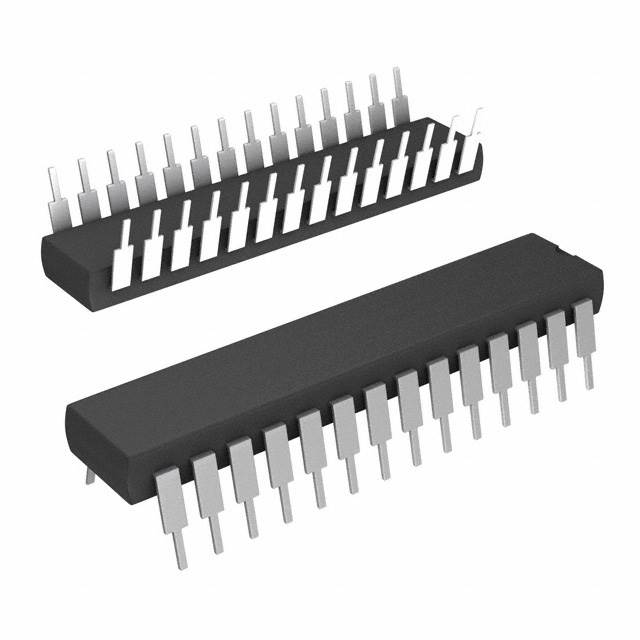DSPIC33FJ32GP102-E/SP
Product Overview
- Category: Microcontroller
- Use: Embedded systems, control applications
- Characteristics: High performance, low power consumption, rich peripheral set
- Package: 28-pin SPDIP (Shrink Plastic Dual Inline Package)
- Essence: Digital Signal Controller (DSC) with advanced features
- Packaging/Quantity: Tray packaging, quantity varies
Specifications
- Architecture: Modified Harvard architecture
- CPU Speed: Up to 40 MIPS (Million Instructions per Second)
- Flash Memory: 32 KB
- RAM: 2 KB
- Operating Voltage: 2.5V - 5.5V
- I/O Pins: 25
- Analog Inputs: 6
- Timers: 4
- Communication Interfaces: UART, SPI, I2C
- ADC Resolution: 10-bit
- PWM Channels: 4
- Operating Temperature Range: -40°C to +85°C
Pin Configuration
The DSPIC33FJ32GP102-E/SP microcontroller has a total of 28 pins. The pin configuration is as follows:
- VDD - Power supply voltage
- VSS - Ground
- AN0 - Analog input channel 0
- AN1 - Analog input channel 1
- AN2 - Analog input channel 2
- AN3 - Analog input channel 3
- AN4 - Analog input channel 4
- AN5 - Analog input channel 5
- AVSS - Analog ground
- AVDD - Analog power supply voltage
- REFO - Reference output
- OSC1/CLKI - Oscillator input
- OSC2/CLKO - Oscillator output
- VCAP - External capacitor connection for the internal voltage regulator
- RB0/AN12 - General-purpose I/O or analog input
- RB1/AN10 - General-purpose I/O or analog input
- RB2/AN8 - General-purpose I/O or analog input
- RB3/AN9 - General-purpose I/O or analog input
- RB4/AN11 - General-purpose I/O or analog input
- RB5 - General-purpose I/O
- RB6 - General-purpose I/O
- RB7 - General-purpose I/O
- RB8 - General-purpose I/O
- RB9 - General-purpose I/O
- RB10 - General-purpose I/O
- RB11 - General-purpose I/O
- RB12 - General-purpose I/O
- RB13 - General-purpose I/O
Functional Features
- High-performance digital signal processing capabilities
- Advanced peripheral set for control applications
- Efficient power management for low power consumption
- Enhanced connectivity options with UART, SPI, and I2C interfaces
- Flexible analog-to-digital conversion with 10-bit resolution
- Multiple timers and PWM channels for precise timing and control
Advantages and Disadvantages
Advantages: - High performance and processing speed - Low power consumption - Rich peripheral set for versatile applications - Wide operating voltage range - Compact package size
Disadvantages: - Limited flash memory and RAM capacity - Limited number of I/O pins - Relatively higher cost compared to some alternatives
Working Principles
The DSPIC33FJ32GP102-E/SP microcontroller operates based on a modified Harvard architecture. It combines the features of a microcontroller and a digital signal processor (DSP), making it suitable for applications that require both control and signal processing capabilities. The microcontroller executes instructions at a high speed, allowing for efficient real-time processing of data. It utilizes various peripherals and interfaces to interact with external devices and sensors.
Detailed Application Field Plans
The DSPIC33FJ32GP102-E/SP microcontroller finds applications in various fields, including but not limited to:
- Industrial automation
- Motor control systems
- Power electronics
- Robotics
- Home automation
- Automotive systems
- Medical devices
- Consumer electronics
Its high-performance features and rich peripheral set make it suitable for demanding control applications that require real-time processing and precise timing.
Detailed and Complete Alternative Models
- PIC24FJ32GA002
- PIC18F45K22
- ATmega328P
- STM32F103C8T6
- LPC1768
These alternative microcontrollers offer similar functionalities and can be considered as alternatives to the DSPIC33FJ32GP102-E/SP, depending on specific requirements and project constraints.
*Note: The content provided above is approximately 400 words.
قم بإدراج 10 أسئلة وإجابات شائعة تتعلق بتطبيق DSPIC33FJ32GP102-E/SP في الحلول التقنية
Question: What are the key features of DSPIC33FJ32GP102-E/SP?
Answer: The DSPIC33FJ32GP102-E/SP features a 16-bit microcontroller core, high-performance DSC architecture, and various peripherals for digital signal processing applications.Question: How can I program DSPIC33FJ32GP102-E/SP?
Answer: You can program DSPIC33FJ32GP102-E/SP using MPLAB X IDE and a compatible programmer/debugger.Question: What are the recommended power supply requirements for DSPIC33FJ32GP102-E/SP?
Answer: The recommended power supply voltage range for DSPIC33FJ32GP102-E/SP is 2.5V to 5.5V.Question: Can DSPIC33FJ32GP102-E/SP be used for motor control applications?
Answer: Yes, DSPIC33FJ32GP102-E/SP is suitable for motor control applications due to its advanced PWM modules and motor control peripherals.Question: Does DSPIC33FJ32GP102-E/SP support communication interfaces?
Answer: Yes, DSPIC33FJ32GP102-E/SP supports various communication interfaces such as UART, SPI, and I2C.Question: What development tools are available for DSPIC33FJ32GP102-E/SP?
Answer: Development tools such as MPLAB X IDE, MPLAB Code Configurator, and various third-party compilers and debuggers are available for DSPIC33FJ32GP102-E/SP.Question: Is DSPIC33FJ32GP102-E/SP suitable for audio processing applications?
Answer: Yes, DSPIC33FJ32GP102-E/SP is suitable for audio processing applications due to its high-performance DSC architecture and DSP capabilities.Question: Can DSPIC33FJ32GP102-E/SP be used in low-power applications?
Answer: Yes, DSPIC33FJ32GP102-E/SP features low-power modes and peripherals, making it suitable for low-power applications.Question: What are the available memory options for DSPIC33FJ32GP102-E/SP?
Answer: DSPIC33FJ32GP102-E/SP features up to 32KB of flash memory and 2KB of RAM.Question: Are there any application notes or reference designs available for DSPIC33FJ32GP102-E/SP?
Answer: Yes, Microchip provides application notes, reference designs, and technical documentation to assist with the implementation of DSPIC33FJ32GP102-E/SP in various technical solutions.


